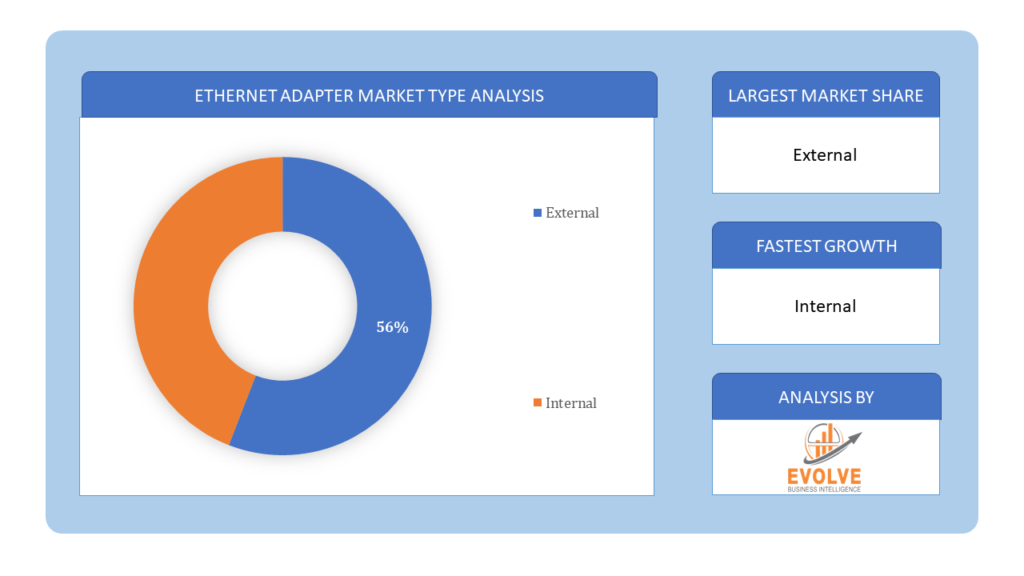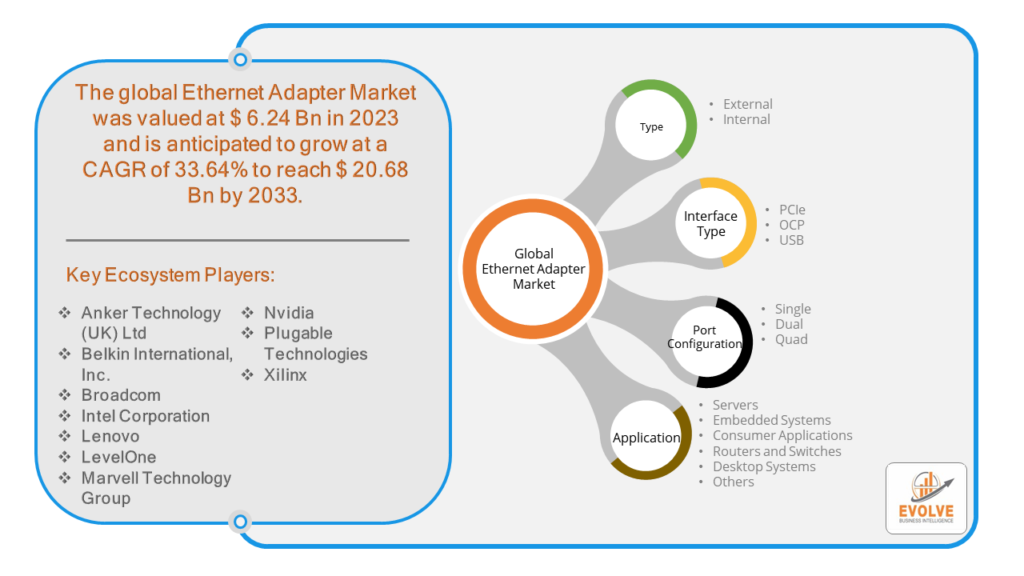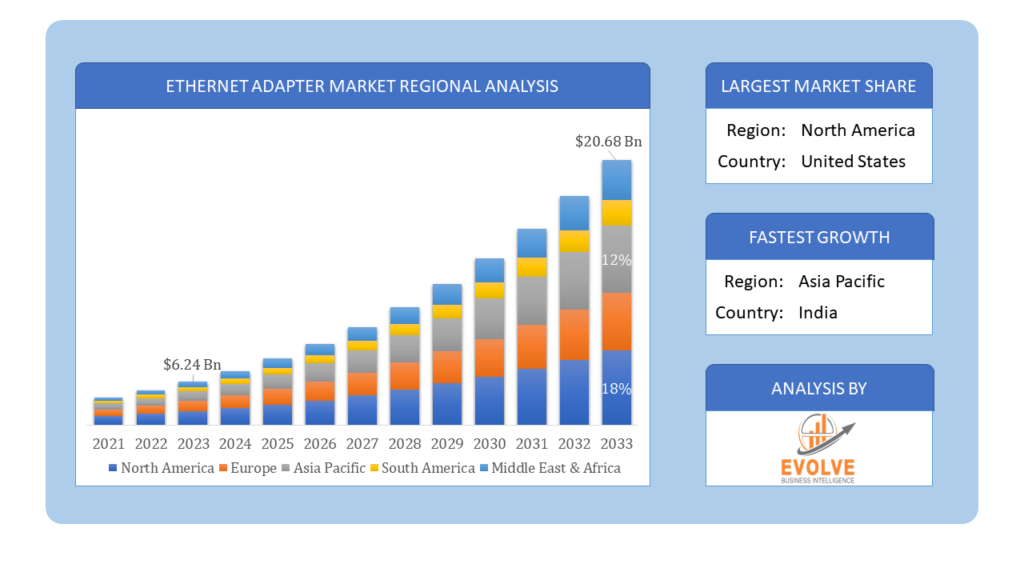Ethernet Adapter Market Analysis and Global Forecast 2023-2033
$ 1,390.00 – $ 5,520.00Price range: $ 1,390.00 through $ 5,520.00
Ethernet Adapter Market Research Report: By Type (External, Internal), By Interface Type (PCIe, OCP, USB), By Port Configuration (Single, Dual, Quad), By Application (Servers, Embedded Systems, Consumer Applications, Routers and Switches, Desktop Systems, Others), and by Region — Forecast till 2033
Page: 162
Ethernet Adapter Market Overview
Ethernet Adapter Market Size is expected to reach USD 20.68 Billion by 2033. The Ethernet Adapter industry size accounted for USD 6.24 Billion in 2023 and is expected to expand at a compound annual growth rate (CAGR) of 33.64% from 2023 to 2033. The Ethernet adapter market encompasses devices that enable Ethernet connectivity in various devices such as computers, servers, and networking equipment. These adapters facilitate the transmission of data over Ethernet networks, supporting speeds ranging from traditional 10/100 Mbps to Gigabit and beyond. Key players in the market include Intel, Broadcom, Realtek, and Qualcomm, among others, offering a range of adapters catering to different network speeds and interface types (PCIe, USB, etc.). Growth in the market is driven by increasing demand for high-speed and reliable network connections in both consumer and enterprise applications, alongside advancements in Ethernet technology.
Global Ethernet Adapter Market Synopsis
The COVID-19 pandemic has led to supply chain disruptions leading to supply shortages or lower demand in the ethernet adapter market. The travel restrictions and social-distancing measures have resulted in a sharp drop in consumer and business spending and this pattern is to continue for some time. The end-user trend and preferences have changed due to the pandemic and have resulted in manufacturers, developers, and service providers adopting various strategies to stabilize the company.
Global Ethernet Adapter Market Dynamics
The major factors that have impacted the growth of Ethernet Adapter are as follows:
Drivers:
⮚ Advancements in Network Technologies
Ethernet adapters are benefiting from ongoing advancements in Ethernet standards, such as the development of 2.5GbE, 5GbE, and 10GbE technologies. These higher-speed standards support faster data transfer rates and lower latency, catering to the increasing bandwidth requirements of modern applications.
Restraint:
- Security Concerns
Ethernet adapters, especially those used in enterprise environments, must adhere to stringent security standards to protect against cyber threats. Ensuring adapter firmware integrity, secure network authentication, and encryption protocols can pose challenges in maintaining robust network security.
Opportunity:
⮚ Transition to Higher Ethernet Speeds
The market shift towards higher Ethernet speeds (e.g., 25GbE, 40GbE, 100GbE) presents opportunities for Ethernet adapter manufacturers. As organizations upgrade their networks to accommodate increasing data volumes and bandwidth-intensive applications, there is a growing demand for adapters that can support these higher speeds effectively.
Ethernet Adapter Market Segment Overview
By Type
 Based on the Type, the market is segmented based on External, Internal. Internal adapters currently dominate due to their integration within devices like desktop computers and servers, offering streamlined connectivity without external components.
Based on the Type, the market is segmented based on External, Internal. Internal adapters currently dominate due to their integration within devices like desktop computers and servers, offering streamlined connectivity without external components.
By Interface Type
Based on Interface Type, the market has been divided into PCIe, OCP, USB. PCIe (Peripheral Component Interconnect Express) currently dominates due to its high performance and widespread adoption in various computing and networking applications.
By Port Configuration
Based on the Port Configuration, the market has been divided into Single, Dual, Quad. They are widely used in various applications due to their cost-effectiveness, simplicity in deployment, and suitability for most networking needs, ranging from consumer electronics to enterprise networking equipment. Dual and quad-port configurations cater to specific high-density and server applications where multiple simultaneous connections are required, but single-port adapters remain the most prevalent choice across the market.
By Application
Based on Application, the market has been divided into Servers, Embedded Systems, Consumer Applications, Routers and Switches, Desktop Systems, Others. Servers require high-speed Ethernet adapters for data center connectivity, while routers and switches use adapters extensively for network infrastructure management and data transfer between devices. These segments drive significant demand due to their critical roles in enterprise networking and data processing environments.
Global Ethernet Adapter Market Regional Analysis
Based on region, the market has been divided into North America, Europe, Asia-Pacific, the Middle East & Africa, and Latin America. The area of Asia-Pacific is anticipated to dominate the market for the usage of Ethernet Adapter, followed by those in North America and Europe.
 Ethernet Adapter Asia-Pacific Market
Ethernet Adapter Asia-Pacific Market
The Asia-Pacific region holds a dominant position in the Ethernet Adapter market. The market for Ethernet switches is expanding significantly in the Asia Pacific area. Due to the region’s enormous population and quickly expanding economy, there is an increasing need for Ethernet switches to support the expansion of a number of businesses, including cloud computing, data centers, and telecommunications. The expansion of the Ethernet Switch market in the Asia Pacific region is also being aided by government investments in digital infrastructure and the rising use of technology by consumers and companies.
Ethernet Adapter North America Market
The North America region is witnessing rapid growth and emerging as a significant market for the Ethernet Adapter industry. The Ethernet switch market in North America is anticipated to expand at the quickest rate possible between 2024 and 2032. In terms of market share, North America is regarded as the leader in the Ethernet switch industry and is a significant player. Because of the extensive use of technology and the requirement for high-speed network connectivity, the region is home to several major players in the industry and has a significant demand for Ethernet switches.
Competitive Landscape
The competitive landscape includes key players (tier 1, tier 2, and local) having a presence across the globe. Companies such as Anker Technology (UK) Ltd, Belkin International, Inc., Broadcom, Intel Corporation, and Lenovo are some of the leading players in the global Ethernet Adapter Industry. These players have adopted partnership, acquisition, expansion, and new product development, among others as their key strategies.
Key Market Players:
- Anker Technology (UK) Ltd
- Belkin International, Inc.
- Broadcom
- Intel Corporation
- Lenovo
- LevelOne
- Marvell Technology Group
- Nvidia
- Plugable Technologies
- Xilinx
Key Development:
In September 2022, Intel Corporation introduced advanced Ethernet adapters featuring enhanced performance, reliability, and compatibility with emerging networking standards, reinforcing its leadership in the Ethernet adapter market.
Scope of the Report
Global Ethernet Adapter Market, by Type
- External
- Internal
Global Ethernet Adapter Market, by Interface Type
- PCIe
- OCP
- USB
Global Ethernet Adapter Market, by Port Configuration
- Single
- Dual
- Quad
Global Ethernet Adapter Market, by Application
- Servers
- Embedded Systems
- Consumer Applications
- Routers and Switches
- Desktop Systems
- Others
Global Ethernet Adapter Market, by Region
- North America
- US
- Canada
- Mexico
- Europe
- UK
- Germany
- France
- Italy
- Spain
- Benelux
- Nordic
- Rest of Europe
- Asia Pacific
- China
- Japan
- South Korea
- Indonesia
- Austalia
- Malaysia
- India
- Rest of Asia Pacific
- South America
- Brazil
- Argentina
- Rest of South America
- Middle East & Africa
- Saudi Arabia
- UAE
- Egypt
- South Africa
- Rest of Middle East & Africa
| Parameters | Indicators |
|---|---|
| Market Size | 2033: $20.68 Billion |
| CAGR | 33.64% CAGR (2023-2033) |
| Base year | 2022 |
| Forecast Period | 2023-2033 |
| Historical Data | 2021 |
| Report Coverage | Revenue Forecast, Competitive Landscape, Growth Factors, and Trends |
| Key Segmentations | Type, Interface Type, Port Configuration, Application |
| Geographies Covered | North America, Europe, Asia-Pacific, Latin America, Middle East, Africa |
| Key Vendors | Anker Technology (UK) Ltd, Belkin International, Inc., Broadcom, Intel Corporation, Lenovo, LevelOne, Marvell Technology Group, Nvidia, Plugable Technologies, Xilinx |
| Key Market Opportunities | M2M communication technology presents a huge opportunity in front of the integrated ethernet switches market |
| Key Market Drivers | Increasing penetration of the internet presence of high-technology adoption |
REPORT CONTENT BRIEF:
- High-level analysis of the current and future Ethernet Adapter Industry trends and opportunities
- Detailed analysis of current market drivers, restraining factors, and opportunities analysis in the future
- Historical market size for the year 2021, and forecast from 2023 to 2033
- Ethernet Adapter market share analysis for each segment
- Competitor analysis with a comprehensive insight into its product segment, financial strength, and strategies adopted.
- Identifies key strategies adopted by the key players including new product development, mergers and acquisitions, joint ventures, collaborations, and partnerships.
- To identify and understand the various factors involved in the global Ethernet Adapter market affected by the pandemic
- To provide year-on-year growth from 2022 to 2033
- To provide short-term, long-term, and overall CAGR comparison from 2022 to 2033.
- Provide Total Addressable Market (TAM) for the Global Ethernet Adapter Market.
Press Release

Global Pharmaceutical Manufacturing Market to Reach $1.38 Trillion by 2035 with 7.35% CAGR, New Research Shows

The Global Mammography Market Is Estimated To Record a CAGR of Around 10.29% During The Forecast Period

Glue Stick Market to Reach USD 2.35 Billion by 2034

Podiatry Service Market to Reach USD 11.88 Billion by 2034

Microfluidics Technology Market to Reach USD 32.58 Billion by 2034

Ferric Chloride Market to Reach USD 10.65 Billion by 2034

Family Practice EMR Software Market to Reach USD 21.52 Billion by 2034

Electric Hairbrush Market to Reach USD 15.95 Billion by 2034

Daily Bamboo Products Market to Reach USD 143.52 Billion by 2034

Cross-border E-commerce Logistics Market to Reach USD 112.65 Billion by 2034
Frequently Asked Questions (FAQ)
1.What is the study period of this market?
- The study period of the global Ethernet Adapter market is 2022- 2033
2.What are the 10 Years CAGR (2023 to 2033) of the global Ethernet Adapter market?
- The global Ethernet Adapter market is growing at a CAGR of ~64% over the next 10 years
3.Which region has the highest growth rate in the market of Ethernet Adapter?
- North America is expected to register the highest CAGR during 2023-2033
4.Which region accounted for the largest share of the market of Ethernet Adapter?
- Asia Pacific holds the largest share in 2022
5.Major Key Players in the Market of Ethernet Adapter?
Anker Technology (UK) Ltd, Belkin International, Inc., Broadcom, Intel Corporation, Lenovo, LevelOne, Marvell Technology Group, Nvidia, Plugable Technologies, and Xilinx are the major companies operating in the Ethernet Adapter Industry
6.Do you offer Post Sale Support?
- Yes, we offer 16 hours of analyst support to solve the queries
7.Do you deliver sections of a report?
Yes, we do provide regional as well as country-level reports. Other than this we also provide a sectional report. Please get in contact with our sales representatives
Table of Content
CHAPTER 1. Executive Summary CHAPTER 2. Scope of the Study 2.1. Market Definition 2.2. Market Scope & Segmentation 2.2.1. Objective of Report CHAPTER 3. Evolve BI Methodology 3.1. Data Collection & Validation Approach 3.2. Market Size Estimation and Forecast CHAPTER 4. Exclusive Analysis 4.1. Market Opportunity Score 4.1.1. Type Segement – Market Opportunity Score 4.1.2. Interface Type Segment – Market Opportunity Score 4.1.3. Port Configuration Segment – Market Opportunity Score 4.1.4. Application Segment – Market Opportunity Score 4.2. Key Market Influencing Indicators CHAPTER 5. Market Insights and Trends 5.1. Value Chain Analysis 5.1.1. Type 5.1.2. Manufacturing Process 5.1.3. Distribution Channel 5.1.4. End User 5.2. Porter’s Five Forces Analysis 5.2.1. Bargaining Power of Buyers 5.2.2. Bargaining Power of Suppliers 5.2.3. Threat of New Entrant 5.2.4. Threat of Substitute 5.2.5. Industry Rivalry 5.3. COVID-19 Impact and Post COVID Scenario on Ethernet Adapter Market 5.3.1. Impact of COVID-19 5.3.2. Government Support and Industry Revival Policies 5.3.3. Measures Taken by Companies to Mitigate Negative Impact 5.3.4. Post COVID Trend CHAPTER 6. MArket Dynamics 6.1. Introduction 6.2. Drivers 6.2.1. Driver 1 6.2.2. Driver 2 6.2.3. Driver 3 6.3. Restraints 6.3.1. Restraint 1 6.3.2. Restraint 2 6.4. Opportunity 6.4.1. Opportunity 1 CHAPTER 7. Global Ethernet Adapter Market, By Type 7.1. Introduction 7.1.1. External 7.1.2. Internal CHAPTER 8. Global Ethernet Adapter Market, By Interface Type 8.1. Introduction 8.1.1. PCIe 8.1.2. OCP 8.1.3. USB CHAPTER 9. Global Ethernet Adapter Market, By Port Configuration 9.1. Introduction 9.1.1. Single 9.1.2. Dual 9.1.3. Quad CHAPTER 10. Global Ethernet Adapter Market, By Application 10.1. Introduction 10.1.1. Servers 10.1.2. Embedded Systems 10.1.3. Consumer Applications 10.1.4. Routers and Switches 10.1.5. Desktop Systems 10.1.6. Others CHAPTER 11. Global Ethernet Adapter Market, By Region 11.1. Introduction 11.2. NORTH AMERICA 11.2.1. North America: Market Size and Forecast, By Country, 2023 – 2033 ($ Million) 11.2.2. North America: Market Size and Forecast, By Type, 2023 – 2033 ($ Million) 11.2.3. North America: Market Size and Forecast, By Interface Type, 2023 – 2033 ($ Million) 11.2.4. North America: Market Size and Forecast, By Port Configuration, 2023 – 2033 ($ Million) 11.2.5. North America: Market Size and Forecast, By Application, 2023 – 2033 ($ Million) 11.2.6. US 11.2.6.1. US: Market Size and Forecast, By Type, 2023 – 2033 ($ Million) 11.2.6.2. US: Market Size and Forecast, By Interface Type, 2023 – 2033 ($ Million) 11.2.6.3. US: Market Size and Forecast, By Port Configuration, 2023 – 2033 ($ Million) 11.2.6.4. US: Market Size and Forecast, By Application, 2023 – 2033 ($ Million) 11.2.7. CANADA 11.2.7.1. Canada: Market Size and Forecast, By Type, 2023 – 2033 ($ Million) 11.2.7.2. Canada: Market Size and Forecast, By Interface Type, 2023 – 2033 ($ Million) 11.2.7.3. Canada: Market Size and Forecast, By Port Configuration, 2023 – 2033 ($ Million) 11.2.7.4. Canada: Market Size and Forecast, By Application, 2023 – 2033 ($ Million) 11.2.8. MEXICO 11.2.8.1. Mexico: Market Size and Forecast, By Type, 2023 – 2033 ($ Million) 11.2.8.2. Mexico: Market Size and Forecast, By Interface Type, 2023 – 2033 ($ Million) 11.2.8.3. Mexico: Market Size and Forecast, By Port Configuration, 2023 – 2033 ($ Million) 11.2.8.4. Mexico: Market Size and Forecast, By Application, 2023 – 2033 ($ Million) 11.3. Europe 11.3.1. Europe: Market Size and Forecast, By Country, 2023 – 2033 ($ Million) 11.3.2. Europe: Market Size and Forecast, By Type, 2023 – 2033 ($ Million) 11.3.3. Europe: Market Size and Forecast, By Interface Type, 2023 – 2033 ($ Million) 11.3.4. Europe: Market Size and Forecast, By Port Configuration, 2023 – 2033 ($ Million) 11.3.5. Europe: Market Size and Forecast, By Application, 2023 – 2033 ($ Million) 11.3.6. U.K. 11.3.6.1. U.K.: Market Size and Forecast, By Type, 2023 – 2033 ($ Million) 11.3.6.2. U.K.: Market Size and Forecast, By Interface Type, 2023 – 2033 ($ Million) 11.3.6.3. U.K.: Market Size and Forecast, By Port Configuration, 2023 – 2033 ($ Million) 11.3.6.4. U.K.: Market Size and Forecast, By Application, 2023 – 2033 ($ Million) 11.3.7. GERMANY 11.3.7.1. Germany: Market Size and Forecast, By Type, 2023 – 2033 ($ Million) 11.3.7.2. Germany: Market Size and Forecast, By Interface Type, 2023 – 2033 ($ Million) 11.3.7.3. Germany: Market Size and Forecast, By Port Configuration, 2023 – 2033 ($ Million) 11.3.7.4. Germany: Market Size and Forecast, By Application, 2023 – 2033 ($ Million) 11.3.8. FRANCE 11.3.8.1. France: Market Size and Forecast, By Type, 2023 – 2033 ($ Million) 11.3.8.2. France: Market Size and Forecast, By Interface Type, 2023 – 2033 ($ Million) 11.3.8.3. France: Market Size and Forecast, By Port Configuration, 2023 – 2033 ($ Million) 11.3.8.4. France: Market Size and Forecast, By Application, 2023 – 2033 ($ Million) 11.3.9. ITALY 11.3.9.1. Italy: Market Size and Forecast, By Type, 2023 – 2033 ($ Million) 11.3.9.2. Italy: Market Size and Forecast, By Interface Type, 2023 – 2033 ($ Million) 11.3.9.3. Italy: Market Size and Forecast, By Port Configuration, 2023 – 2033 ($ Million) 11.3.9.4. Italy: Market Size and Forecast, By Application, 2023 – 2033 ($ Million) 11.3.10. SPAIN 11.3.10.1. Spain: Market Size and Forecast, By Type, 2023 – 2033 ($ Million) 11.3.10.2. Spain: Market Size and Forecast, By Interface Type, 2023 – 2033 ($ Million) 11.3.10.3. Spain: Market Size and Forecast, By Port Configuration, 2023 – 2033 ($ Million) 11.3.10.4. Spain: Market Size and Forecast, By Application, 2023 – 2033 ($ Million) 11.3.11. BENELUX 11.3.11.1. BeNeLux: Market Size and Forecast, By Type, 2023 – 2033 ($ Million) 11.3.11.2. BeNeLux: Market Size and Forecast, By Interface Type, 2023 – 2033 ($ Million) 11.3.11.3. BeNeLux: Market Size and Forecast, By Port Configuration, 2023 – 2033 ($ Million) 11.3.11.4. BeNeLux: Market Size and Forecast, By Application, 2023 – 2033 ($ Million) 11.3.12. RUSSIA 11.3.12.1. Russia: Market Size and Forecast, By Type, 2023 – 2033 ($ Million) 11.3.12.2. Russia: Market Size and Forecast, By Interface Type, 2023 – 2033 ($ Million) 11.3.12.3. Russia: Market Size and Forecast, By Port Configuration, 2023 – 2033 ($ Million) 11.3.12.4. Russia: Market Size and Forecast, By Application, 2023 – 2033 ($ Million) 11.3.13. REST OF EUROPE 11.3.13.1. Rest of Europe: Market Size and Forecast, By Type, 2023 – 2033 ($ Million) 11.3.13.2. Rest of Europe: Market Size and Forecast, By Interface Type, 2023 – 2033 ($ Million) 11.3.13.3. Rest of Europe: Market Size and Forecast, By Port Configuration, 2023 – 2033 ($ Million) 11.3.13.4. Rest of Europe: Market Size and Forecast, By Application, 2023 – 2033 ($ Million) 11.4. Asia Pacific 11.4.1. Asia Pacific: Market Size and Forecast, By Country, 2023 – 2033 ($ Million) 11.4.2. Asia Pacific: Market Size and Forecast, By Type, 2023 – 2033 ($ Million) 11.4.3. Asia Pacific: Market Size and Forecast, By Interface Type, 2023 – 2033 ($ Million) 11.4.4. Asia Pacific: Market Size and Forecast, By Port Configuration, 2023 – 2033 ($ Million) 11.4.5. Asia Pacific: Market Size and Forecast, By Application, 2023 – 2033 ($ Million) 11.4.6. CHINA 11.4.6.1. China: Market Size and Forecast, By Type, 2023 – 2033 ($ Million) 11.4.6.2. China: Market Size and Forecast, By Interface Type, 2023 – 2033 ($ Million) 11.4.6.3. China: Market Size and Forecast, By Port Configuration, 2023 – 2033 ($ Million) 11.4.6.4. China: Market Size and Forecast, By Application, 2023 – 2033 ($ Million) 11.4.7. JAPAN 11.4.7.1. Japan: Market Size and Forecast, By Type, 2023 – 2033 ($ Million) 11.4.7.2. Japan: Market Size and Forecast, By Interface Type, 2023 – 2033 ($ Million) 11.4.7.3. Japan: Market Size and Forecast, By Port Configuration, 2023 – 2033 ($ Million) 11.4.7.4. Japan: Market Size and Forecast, By Application, 2023 – 2033 ($ Million) 11.4.8. INDIA 11.4.8.1. India: Market Size and Forecast, By Type, 2023 – 2033 ($ Million) 11.4.8.2. India: Market Size and Forecast, By Interface Type, 2023 – 2033 ($ Million) 11.4.8.3. India: Market Size and Forecast, By Port Configuration, 2023 – 2033 ($ Million) 11.4.8.4. India: Market Size and Forecast, By Application, 2023 – 2033 ($ Million) 11.4.9. SOUTH KOREA 11.4.9.1. South Korea: Market Size and Forecast, By Type, 2023 – 2033 ($ Million) 11.4.9.2. South Korea: Market Size and Forecast, By Interface Type, 2023 – 2033 ($ Million) 11.4.9.3. South Korea: Market Size and Forecast, By Port Configuration, 2023 – 2033 ($ Million) 11.4.9.4. South Korea: Market Size and Forecast, By Application, 2023 – 2033 ($ Million) 11.4.10. THAILAND 11.4.10.1. Thailand: Market Size and Forecast, By Type, 2023 – 2033 ($ Million) 11.4.10.2. Thailand: Market Size and Forecast, By Interface Type, 2023 – 2033 ($ Million) 11.4.10.3. Thailand: Market Size and Forecast, By Port Configuration, 2023 – 2033 ($ Million) 11.4.10.4. Thailand: Market Size and Forecast, By Application, 2023 – 2033 ($ Million) 11.4.11. INDONESIA 11.4.11.1. Indonesia: Market Size and Forecast, By Type, 2023 – 2033 ($ Million) 11.4.11.2. Indonesia: Market Size and Forecast, By Interface Type, 2023 – 2033 ($ Million) 11.4.11.3. Indonesia: Market Size and Forecast, By Port Configuration, 2023 – 2033 ($ Million) 11.4.11.4. Indonesia: Market Size and Forecast, By Application, 2023 – 2033 ($ Million) 11.4.12. MALAYSIA 11.4.12.1. Malaysia: Market Size and Forecast, By Type, 2023 – 2033 ($ Million) 11.4.12.2. Malaysia: Market Size and Forecast, By Interface Type, 2023 – 2033 ($ Million) 11.4.12.3. Malaysia: Market Size and Forecast, By Port Configuration, 2023 – 2033 ($ Million) 11.4.12.4. Malaysia: Market Size and Forecast, By Application, 2023 – 2033 ($ Million) 11.4.13. AUSTRALIA 11.4.13.1. Australia: Market Size and Forecast, By Type, 2023 – 2033 ($ Million) 11.4.13.2. Australia: Market Size and Forecast, By Interface Type, 2023 – 2033 ($ Million) 11.4.13.3. Australia: Market Size and Forecast, By Port Configuration, 2023 – 2033 ($ Million) 11.4.13.4. Australia: Market Size and Forecast, By Application, 2023 – 2033 ($ Million) 11.4.14. REST FO ASIA PACIFIC 11.4.14.1. Rest fo Asia Pacific: Market Size and Forecast, By Type, 2023 – 2033 ($ Million) 11.4.14.2. Rest fo Asia Pacific: Market Size and Forecast, By Interface Type, 2023 – 2033 ($ Million) 11.4.14.3. Rest fo Asia Pacific: Market Size and Forecast, By Port Configuration, 2023 – 2033 ($ Million) 11.4.14.4. Rest fo Asia Pacific: Market Size and Forecast, By Application, 2023 – 2033 ($ Million) 11.5. South America 11.5.1. South America: Market Size and Forecast, By Country, 2023 – 2033 ($ Million) 11.5.2. South America: Market Size and Forecast, By Type, 2023 – 2033 ($ Million) 11.5.3. South America: Market Size and Forecast, By Interface Type, 2023 – 2033 ($ Million) 11.5.4. South America: Market Size and Forecast, By Port Configuration, 2023 – 2033 ($ Million) 11.5.5. South America: Market Size and Forecast, By Application, 2023 – 2033 ($ Million) 11.5.6. BRAZIL 11.5.6.1. Brazil: Market Size and Forecast, By Type, 2023 – 2033 ($ Million) 11.5.6.2. Brazil: Market Size and Forecast, By Interface Type, 2023 – 2033 ($ Million) 11.5.6.3. Brazil: Market Size and Forecast, By Port Configuration, 2023 – 2033 ($ Million) 11.5.6.4. Brazil: Market Size and Forecast, By Application, 2023 – 2033 ($ Million) 11.5.7. ARGENTINA 11.5.7.1. Argentina: Market Size and Forecast, By Type, 2023 – 2033 ($ Million) 11.5.7.2. Argentina: Market Size and Forecast, By Interface Type, 2023 – 2033 ($ Million) 11.5.7.3. Argentina: Market Size and Forecast, By Port Configuration, 2023 – 2033 ($ Million) 11.5.7.4. Argentina: Market Size and Forecast, By Application, 2023 – 2033 ($ Million) 11.5.8. REST OF SOUTH AMERICA 11.5.8.1. Rest of South America: Market Size and Forecast, By Type, 2023 – 2033 ($ Million) 11.5.8.2. Rest of South America: Market Size and Forecast, By Interface Type, 2023 – 2033 ($ Million) 11.5.8.3. Rest of South America: Market Size and Forecast, By Port Configuration, 2023 – 2033 ($ Million) 11.5.8.4. Rest of South America: Market Size and Forecast, By Application, 2023 – 2033 ($ Million) 11.6. Middle East & Africa 11.6.1. Middle East & Africa: Market Size and Forecast, By Country, 2023 – 2033 ($ Million) 11.6.2. Middle East & Africa: Market Size and Forecast, By Type, 2023 – 2033 ($ Million) 11.6.3. Middle East & Africa: Market Size and Forecast, By Interface Type, 2023 – 2033 ($ Million) 11.6.4. Middle East & Africa: Market Size and Forecast, By Port Configuration, 2023 – 2033 ($ Million) 11.6.5. Middle East & Africa: Market Size and Forecast, By Application, 2023 – 2033 ($ Million) 11.6.6. SAUDI ARABIA 11.6.6.1. Saudi Arabia: Market Size and Forecast, By Type, 2023 – 2033 ($ Million) 11.6.6.2. Saudi Arabia: Market Size and Forecast, By Interface Type, 2023 – 2033 ($ Million) 11.6.6.3. Saudi Arabia: Market Size and Forecast, By Port Configuration, 2023 – 2033 ($ Million) 11.6.6.4. Saudi Arabia: Market Size and Forecast, By Application, 2023 – 2033 ($ Million) 11.6.7. UAE 11.6.7.1. UAE: Market Size and Forecast, By Type, 2023 – 2033 ($ Million) 11.6.7.2. UAE: Market Size and Forecast, By Interface Type, 2023 – 2033 ($ Million) 11.6.7.3. UAE: Market Size and Forecast, By Port Configuration, 2023 – 2033 ($ Million) 11.6.7.4. UAE: Market Size and Forecast, By Application, 2023 – 2033 ($ Million) 11.6.8. EGYPT 11.6.8.1. Egypt: Market Size and Forecast, By Type, 2023 – 2033 ($ Million) 11.6.8.2. Egypt: Market Size and Forecast, By Interface Type, 2023 – 2033 ($ Million) 11.6.8.3. Egypt: Market Size and Forecast, By Port Configuration, 2023 – 2033 ($ Million) 11.6.8.4. Egypt: Market Size and Forecast, By Application, 2023 – 2033 ($ Million) 11.6.9. SOUTH AFRICA 11.6.9.1. South Africa: Market Size and Forecast, By Type, 2023 – 2033 ($ Million) 11.6.9.2. South Africa: Market Size and Forecast, By Interface Type, 2023 – 2033 ($ Million) 11.6.9.3. South Africa: Market Size and Forecast, By Port Configuration, 2023 – 2033 ($ Million) 11.6.9.4. South Africa: Market Size and Forecast, By Application, 2023 – 2033 ($ Million) 11.6.10. REST OF MIDDLE EAST & AFRICA 11.6.10.1. Rest of Middle East & Africa: Market Size and Forecast, By Type, 2023 – 2033 ($ Million) 11.6.10.2. Rest of Middle East & Africa: Market Size and Forecast, By Interface Type, 2023 – 2033 ($ Million) 11.6.10.3. Rest of Middle East & Africa: Market Size and Forecast, By Port Configuration, 2023 – 2033 ($ Million) 11.6.10.4. Rest of Middle East & Africa: Market Size and Forecast, By Application, 2023 – 2033 ($ Million) CHAPTER 12. Competitive Landscape 12.1. Competitior Benchmarking 2023 12.2. Market Share Analysis 12.3. Key Developments Analysis By Top 5 Companies 12.4. Market Share Acquisition Strategies: Analysis of Key Approaches Employed by Top Players CHAPTER 13. Company Profiles 13.1. Anker Technology (UK) Ltd 13.1.1. Business Overview 13.1.2. Financial Analysis 13.1.2.1. Business Segment Revenue, 2018, 2019, 2020, $ Million 13.1.2.2. Geographic Revenue Mix, 2020 (% Share) 13.1.3. Product Portfolio 13.1.4. Recent Development and Strategies Adopted 13.1.5. SWOT Analysis 13.2. Belkin International, Inc. 13.3. Broadcom 13.4. Intel Corporation 13.5. Lenovo 13.6. LevelOne 13.7. Marvell Technology Group 13.8. Nvidia 13.9. Plugable Technologies 13.10. Xilinx
Connect to Analyst
Research Methodology








